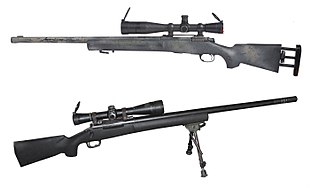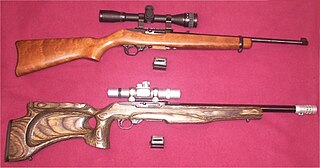Handloading, or reloading, is the practice of making firearm cartridges by assembling the individual components, rather than purchasing mass-assembled, factory-loaded ammunition.

A rifle is a long-barreled firearm designed for accurate shooting and higher stopping power, with a barrel that has a helical pattern of grooves (rifling) cut into the bore wall. In keeping with their focus on accuracy, rifles are typically designed to be held with both hands and braced firmly against the shooter's shoulder via a buttstock for stability during shooting. Rifles are used extensively in warfare, law enforcement, hunting and target shooting sports.

The Colt AR-15 is a lightweight, magazine-fed, gas-operated semi-automatic rifle. It is a semi-automatic version of the M16 rifle sold for the civilian and law enforcement markets in the United States. The AR in AR-15 stands for ArmaLite rifle, after the company that developed it in the 1950s. Colt's Manufacturing Company currently owns the AR-15 trademark, which is used exclusively for its line of semi-automatic AR-15 rifles.

An air gun or airgun is a gun that uses energy from compressed air or other gases that are mechanically pressurized and then released to propel and accelerate projectiles, similar to the principle of the primitive blowgun. This is in contrast to a firearm, which shoots projectiles using energy generated via exothermic combustion (deflagration) of chemical propellants, most often black powder or smokeless powder.

A sniper rifle is a high-precision, long-range rifle. Requirements include high accuracy, reliability, and mobility, concealment, and optics, for anti-personnel, anti-materiel and surveillance uses by military snipers. The modern sniper rifle is a portable shoulder-fired rifle with either a bolt action or semi-automatic action, fitted with a telescopic sight for extreme accuracy and chambered for a high-ballistic performance centerfire cartridge.

External ballistics or exterior ballistics is the part of ballistics that deals with the behavior of a projectile in flight. The projectile may be powered or un-powered, guided or unguided, spin or fin stabilized, flying through an atmosphere or in the vacuum of space, but most certainly flying under the influence of a gravitational field.

The .22 Long Rifle, also known as the .22LR or 5.6×15mmR, is a long-established variety of .22 caliber rimfire ammunition originating from the United States. It is used in a wide range of firearms including rifles, pistols, revolvers, and submachine guns.

A wildcat cartridge, often shortened to wildcat, is a custom cartridge for which ammunition and/or firearms are not mass-produced. These cartridges are often created in order to optimize a certain performance characteristic of an existing commercial cartridge, or may merely be intended as novelty items.

Accurizing is the process of improving the accuracy and precision of a gun.

Benchrest shooting is a shooting sport discipline in which high-precision rifles are rested on a table or bench – rather than being carried in the shooter's hands – while shooting at paper or steel targets, hence the name "benchrest". Both the forearm and buttstock of such a rifle are usually fully supported by bean bags, a bipod/monopod (front/rear) combination, and/or a specially designed fixture device called shooting rest, so that the gun can remain stably pointing at the target without needing to be held by someone. When shooting, the shooter simply sits/stands comfortably behind the table/bench, operates the action and pulls the trigger, without needing to worry about carrying any weight of the gun. This is in contrast to other shooting disciplines, where the shooter has to bear at least part of the gun's weight while holding it steady to aim, even when using support devices such as bipods, tripods or shooting sticks.

The .30-378 Weatherby Magnum is a .30 caliber, belted, bottle-necked rifle cartridge. The cartridge was developed in response to a US Army military contract in 1959. While still unreleased to the public, the cartridge went on to set world records for accuracy including the first ten 10X in 1,000 yards (910 m) benchrest shooting. It is currently the highest velocity .30 caliber factory ammunition available.

A free-floating barrel is a firearm design used in precision rifles, particularly match grade benchrest rifles, to accurize the weapon system.

The major components of sniper equipment are the precision sniper rifle, various optical scopes and field glasses, specialized ammunition and camouflage materials for the sniper’s body and equipment. A sniper’s spotter typically also wears camouflage. In the 2010s, a spotter uses various optical gear and in some cases a laser rangefinder. Snipers may also use monopods, bipods or tripods to steady their aim.

The DSR-1 is a compact bolt-action sniper rifle designed, manufactured and marketed by the German company DSR-Precision GmbH and was also marketed by the German company AMP Technical Services as a specialized sniper rifle for police sharpshooters. It has been adopted by the German counter-terrorist unit GSG 9, as well as by other European special police units and agencies.
The following are terms related to firearms and ammunition topics.

The Lobaev sniper rifle is a rifle line of custom-built bolt-action sniper rifles manufactured by Lobaev Arms, which produces benchrest equipment and long-range, sniper and mountain hunting rifles in Tarusa, Russia. The Lobaev rifles are based on a single-shot bolt-action designed for benchrest shooting by Vladislav Lobaev. The chambering, barrel, stock, ammunition feeding method and other rifle characteristics are determined by the clients' preferences.

TrackingPoint is an applied technology company based in Austin, Texas. In 2011, it created a long-range rifle system that was the first precision guided firearm.

Long range shooting is a collective term for shooting disciplines where the distance to target is significant enough that shooter has to put effort into calculating various ballistic factors, especially in regards to the deviating effects of gravity and wind. While shooting at shorter ranges, a shooter only has to slightly adjust the sights to compensate for limited bullet drop at most, but when the range is extended, wind drift will be the first factor affecting precision to the extent that it must be taken into serious account. Some would argue that long range shooting starts where assessment of wind, distance and various atmospheric conditions are equally important for the results as pure shooting skills - meaning that even if one conducts a technically perfect shot, the shooter will miss the target because of incorrect calculations, neglecting to take some elements into consideration, or merely due to unpredictable downrange conditions. It is widely accepted within interdisciplinary circles that for a standard rifle firing full-powered cartridges, "long range" means the target is more than 600 m (660 yd) away,, while "extreme long range" is generally accepted as when the target distance is more than 1,000 m (1,100 yd) away from the shooter.

In ranged weapons such as firearms and artillery pieces, the act of sighting in or sight-in is a preparatory or corrective calibration of the sights with the goal of having the projectile placed on a predictable impact position in relation to the sight picture. The principle of sighting-in is to shift the line of aim until it intersects the parabolic projectile trajectory at a designated point of reference, so when the gun is fired in the future it will repeatably hit where it aims at identical distances of that designated point.
Gun dynamics encompasses aspects of gun technology, such as recoil and impact. In the 1970s, the United States Army Symposium on Gun Dynamics defined it as the study of internal ballistics that are unrelated to propellants and combustion. In particular, it is concerned with the interactive dynamics between the projectile, barrel, and mounting, and the effect that they have on the accuracy and consistency of the gun.
















